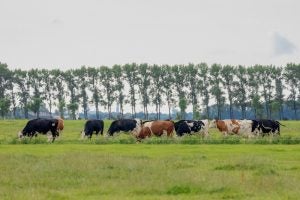Thousands of farmers in the Netherlands have been hitting the streets on their tractors to rally against new emission regulations from the Dutch government. Less than a century ago, food security was a priority for this European country, but now, officials may have forgotten those roots.

With over 50,000 farmers and millions of animals occupying the Netherlands, many are now facing shutdowns. New regulations may force farmers to cut production and herd numbers by up to 30 percent to meet emission requirements by the state.
The government is slated to cut nitrogen oxide and ammonia by 50 percent by 2030 and has already allocated €25 billion to assist in shifting farms to meet new requirements. The government in the past has called on farmers to use feed for their animals that contains less protein as a way of reducing ammonia emissions.
»Related: Perspective: The EU’s carbon-neutral farm plan masks the real impact
Farms near national parks are being hit the hardest. Claiming that ecosystems have been damaged by nitrogen pollution, the government plans to cut greenhouse gas nitrogen by up to 70 percent in areas closer to nature reserves.
Over 40,000 farmers have gathered to protest the new regulations, taking to the highways and cities on their tractors.
“I don’t think I have a future in farming because we must reduce our cattle by 70 percent. With only 80 cows, this won’t be profitable, so we will have to close,” Jessee Baars, a young Dutch dairy farmer, told France 24.
The Netherlands raises a food surplus yearly and is the second-largest exporter of agricultural commodities behind the United States. Even more impressively, the Dutch do this in a country that is 270 times smaller than the United States.
There was, however, a time when the Dutch faced starvation. In 1944, Nazis occupied the Netherlands and blockaded the North. Food was scarce, and the government encouraged its citizens to forage for acorns and chestnuts. Tens of thousands of Dutch people died from famine. After World War II, the country focused on ensuring food security and supporting larger, high-efficiency farming operations.
The European Union has criticized the country for intensive methods and excessive synthetic fertilizer usage. However, the Netherlands has not only cut its fertilizer use in half but also utilizes far less water than the global average to grow crops such as tomatoes. Tomatoes, in particular, use four liters per kilogram of tomatoes grown, compared to the worldwide average of 214 liters.


